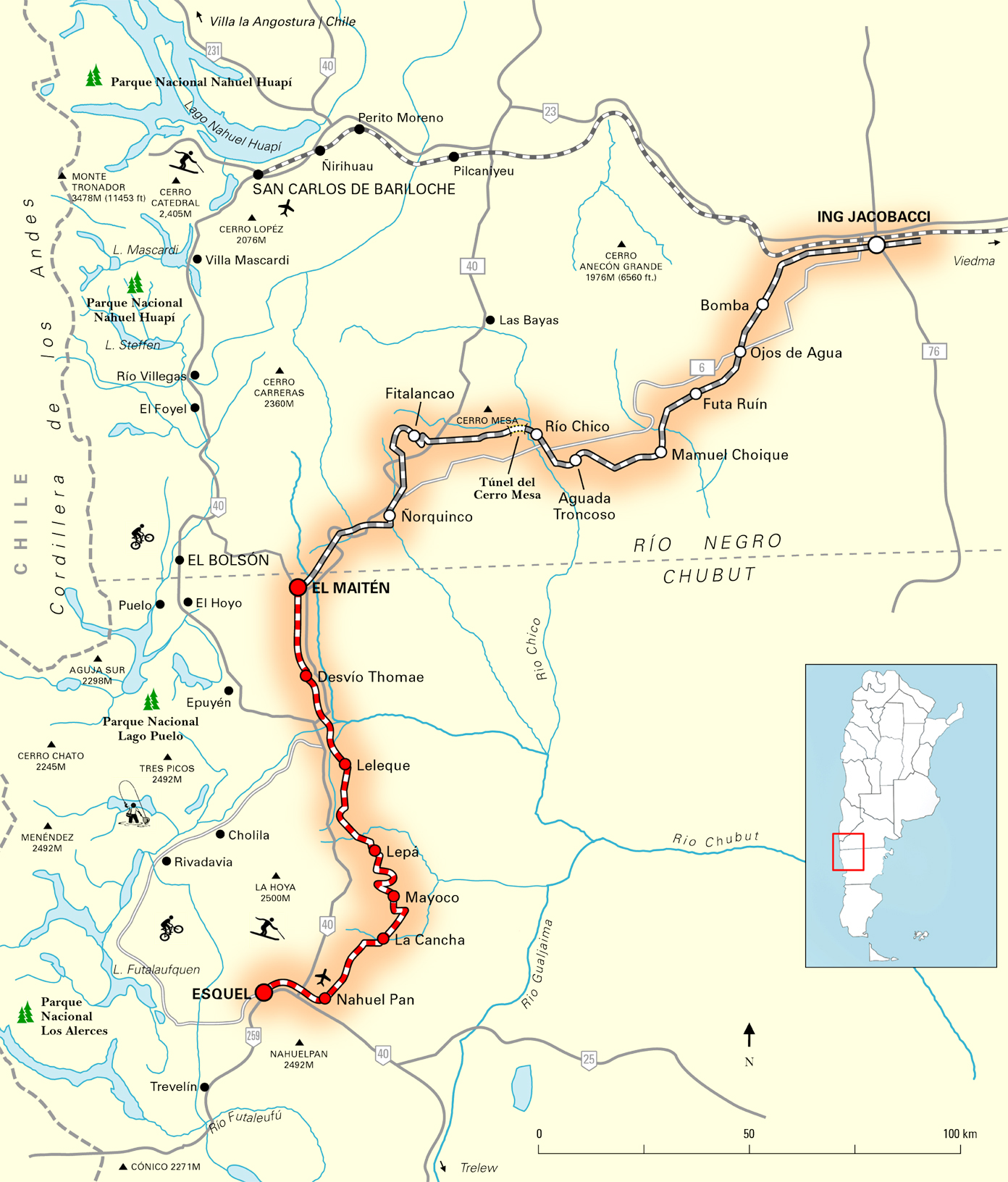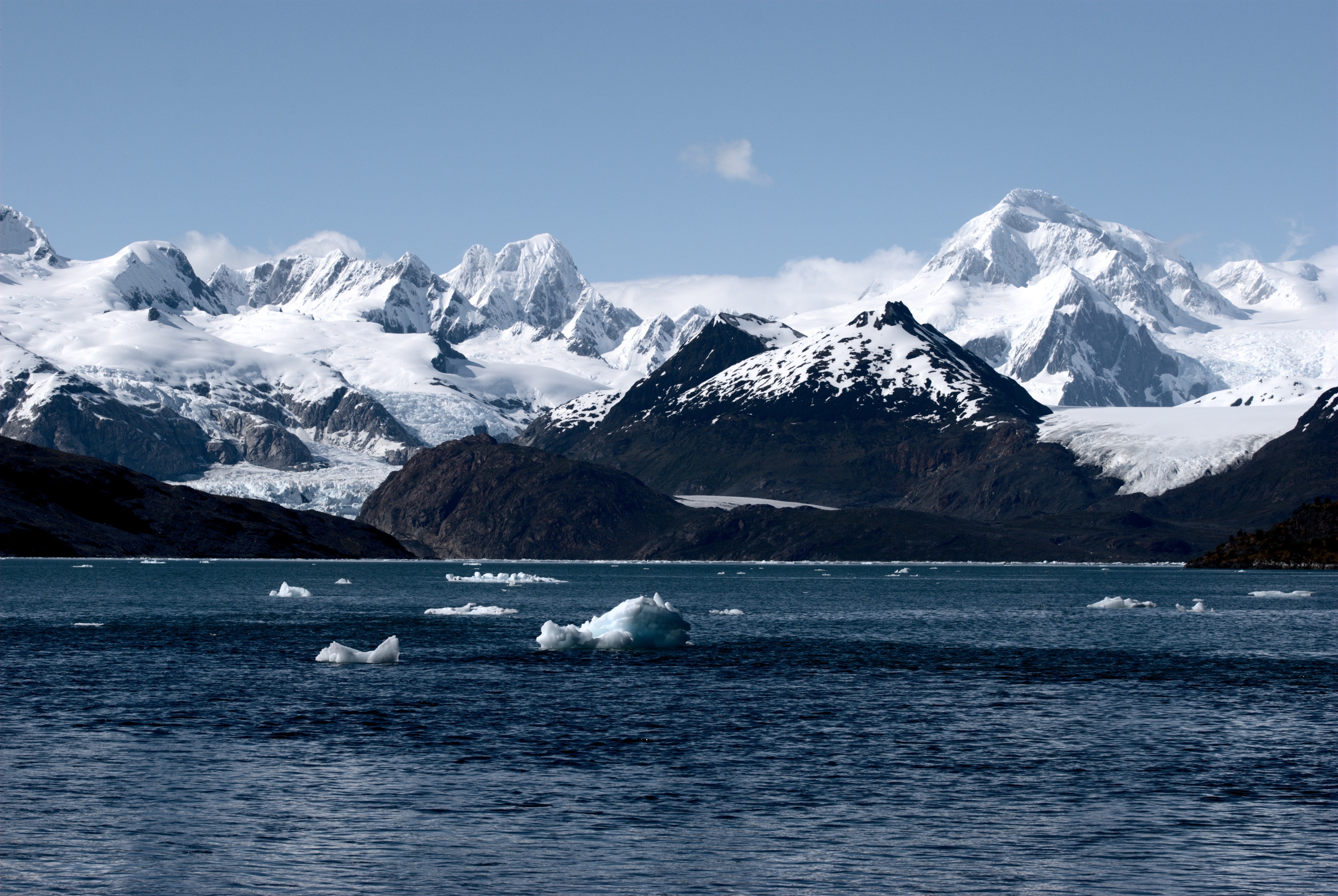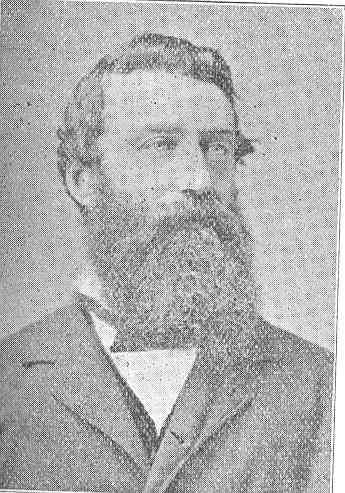|
Esquel
Esquel is a town in the northwest of Chubut Province in Argentine Patagonia. It is located in Futaleufú Department, of which it is the government seat. Esquel is the home station for “La Trochita,” a historic narrow gauge railway known in English as “The Old Patagonian Express.” Esquel is also known for its ski area, “La Hoya,” and as a gateway city to Los Alerces National Park, a UNESCO protected reserve featuring some of the oldest trees in South America. The name Esquel derives from one of two Tehuelche words: one meaning "marsh" and the other meaning "land of burrs", which refers to the many thorny plants including the pimpinella, and the other meaning herbaceous plants whose fruits, when ripe, turn into prickly burrs that stick to the animals' skins and wool or people's clothes as a way of propagation. History The founding of the town dates back to the arrival of Welsh immigrants in Chubut in 1865. The settlement was created on 25 February 1906, as an extens ... [...More Info...] [...Related Items...] OR: [Wikipedia] [Google] [Baidu] |
Old Patagonian Express
La Trochita (official name: ''Viejo Expreso Patagónico''), in English known as the Old Patagonian Express, is a narrow gauge railway in Patagonia, Argentina using steam locomotives. The nickname ''La Trochita'' means literally "The little gauge" though it is sometimes translated as "The Little Narrow Gauge" in Spanish while "trocha estrecha", "trocha angosta" in Argentina, is often used for a generic description of "narrow gauge." The Trochita railway is 402 km in length and runs through the foothills of the Andes between Esquel and El Maitén in Chubut Province and Ingeniero Jacobacci in Río Negro Province, originally it was part of Ferrocarriles Patagónicos, a network of railways in southern Argentina. Nowadays, with its original character largely unchanged, it operates as a heritage railway and was made internationally famous by the 1978 Paul Theroux book '' The Old Patagonian Express'', which described it as the railway almost at the end of the world. Theroux had ... [...More Info...] [...Related Items...] OR: [Wikipedia] [Google] [Baidu] |
La Trochita
La Trochita (official name: ''Viejo Expreso Patagónico''), in English language, English known as the Old Patagonian Express, is a narrow gauge railway in Patagonia, Argentina using steam locomotives. The nickname ''La Trochita'' means literally "The little gauge" though it is sometimes translated as "The Little Narrow Gauge" in Spanish language, Spanish while "trocha estrecha", "trocha angosta" in Argentina, is often used for a generic description of "narrow gauge." The Trochita railway is 402 km in length and runs through the foothills of the Andes between Esquel and El Maitén in Chubut Province and Ingeniero Jacobacci in Río Negro Province, originally it was part of Ferrocarriles Patagónicos, a network of railways in southern Argentina. Nowadays, with its original character largely unchanged, it operates as a heritage railway and was made internationally famous by the 1978 Paul Theroux book ''The Old Patagonian Express'', which described it as the railway almost at the ... [...More Info...] [...Related Items...] OR: [Wikipedia] [Google] [Baidu] |
Chubut Province
Chubut ( from Tehuelche language, Tehuelche 'transparent'; ) is a provinces of Argentina, province in southern Argentina, situated between the 42nd parallel south (the border with Río Negro Province), the 46th parallel south (bordering Santa Cruz Province, Argentina, Santa Cruz Province), the Andes range to the west (bordering Chile), and the Atlantic Ocean to the east. The province's name derives from the Tehuelche language, Tehuelche word , meaning 'transparent', their description of the Chubut River. The largest city is Comodoro Rivadavia in the south of the province; it has 180,000 inhabitants. The administrative capital is Rawson, Chubut, Rawson (40,000). Other important cities are Puerto Madryn, Trelew, Esquel and Sarmiento, Chubut, Sarmiento. Gaiman, Chubut, Gaiman is a cultural and demographic centre of the region known as in which Welsh settlement in Argentina, Welsh-Argentines are concentrated. History Before the Spain, Spaniards arrived in the Americas, nomadic ... [...More Info...] [...Related Items...] OR: [Wikipedia] [Google] [Baidu] |
Futaleufú Department
Futaleufú () is a department in the north west of Chubut Province, Argentina. Its main town and capital is Esquel to the north, with Trevelin and El Corcovado as the only other towns of significant size. Other settlements are Cerro Centinela, Aldea Escolar, Los Cipreses and Lago Rosario. The population of the department is 37,500 inhabitants as per the , which represents a population density of fewer than 4 inhabitants/km2. The partido is bordered to the north by the Cushamen Department, to the south and east by the Languiñeo Department and to the west by Chile. The name comes from the Futaleufú River, which originates in the Los Alerces National Park and flows through the department into Chile and on to the Pacific Ocean. Settlements * Esquel * Trevelin * Corcovado * Lago Rosario * Aldea Escolar * Los Cipreses * Villa Futalaufquen *Cerro Centinela Cerro Centinela is a village and municipality in Chubut Province in southern Argentina Argentina, officia ... [...More Info...] [...Related Items...] OR: [Wikipedia] [Google] [Baidu] |
Patagonia
Patagonia () is a geographical region that includes parts of Argentina and Chile at the southern end of South America. The region includes the southern section of the Andes mountain chain with lakes, fjords, temperate rainforests, and glaciers in the west and Patagonian Desert, deserts, Plateaus, tablelands, and steppes to the east. Patagonia is bounded by the Pacific Ocean on the west, the Atlantic Ocean to the east, and many bodies of water that connect them, such as the Strait of Magellan, the Beagle Channel, and the Drake Passage to the south. The northern limit of the region is not precisely defined; the Colorado River, Argentina, Colorado and Barrancas River, Barrancas rivers, which run from the Andes to the Atlantic, are commonly considered the northern limit of Argentine Patagonia. The archipelago of Tierra del Fuego is sometimes considered part of Patagonia. Most geographers and historians locate the northern limit of Chilean Patagonia at Huincul Fault, in Araucanía R ... [...More Info...] [...Related Items...] OR: [Wikipedia] [Google] [Baidu] |
Matías Taccetta
Matías Federico Taccetta (born 17 September 1977) is an Argentine politician. A member of Republican Proposal (PRO), he was a member of the Chamber of Deputies elected in Chubut Province from 2021 to 2023. In 2023 he was elected '' intendente'' (mayor) of Esquel Esquel is a town in the northwest of Chubut Province in Argentine Patagonia. It is located in Futaleufú Department, of which it is the government seat. Esquel is the home station for “La Trochita,” a historic narrow gauge railway known in En .... Biography Taccetta was an accountant before he was elected. References {{DEFAULTSORT:Taccetta, Matias 1977 births Living people Members of the Argentine Chamber of Deputies elected in Chubut Republican Proposal politicians Mayors of places in Argentina Argentine deputies 2021–2023 ... [...More Info...] [...Related Items...] OR: [Wikipedia] [Google] [Baidu] |
Y Wladfa
Y Wladfa (, 'The Colony'), also occasionally Y Wladychfa Gymreig (, 'The Welsh Settlement'), refers to the establishment of settlements by Welsh colonists and immigrants in the Argentine Patagonia, beginning in 1865, mainly along the coast of the lower Chubut Valley. In 1881, the area became part of the Chubut National Territory of Argentina which, in 1955, became Chubut Province. In the 19th and early 20th centuries, the Argentine government encouraged emigration from Europe to populate Argentina and south Patagonia particularly, which until the Conquest of the Desert had sparsely rural and coastal settlements. Between 1856 and 1875, 34 settlements of immigrants of various nationalities were established in Santa Fe and Entre Ríos. In addition to the main colony in Chubut, a smaller colony was set up in Santa Fe by 44 Welsh people who left Chubut, and another group settled at Coronel Suárez in southern Buenos Aires Province. The Welsh-Argentine community is centred ... [...More Info...] [...Related Items...] OR: [Wikipedia] [Google] [Baidu] |
Trevelin
Trevelin (; ) is a town in the western part of the Patagonian Argentine province of Chubut. The town lies on the eastern banks of the (). It is located in the department of Futaleufú, south of Esquel, and had 6,395 inhabitants at the time of the and 7,908 inhabitants in the . History The town was important in the Welsh settlement of Chubut. It was named Trevelin (from ''Trefelin'', the Welsh for "mill town") after the first flour mill, known as "Los Andes", was established there by in 1891. Evans had previously become well known for leading expeditions into the Pampas in search of new lands and mineral reserves, which had earned him the nickname 'El Baqueano' (meaning guide or scout). One of the tourist attractions of Trevelín is the grave of Malacara, Evans' horse, who a few years earlier in 1884 had saved his master's life by escaping down a steep ravine when his travelling party was attacked by a group of indigenous people led by Cacique (chief) Foyel. The th ... [...More Info...] [...Related Items...] OR: [Wikipedia] [Google] [Baidu] |
Ingeniero Jacobacci
Ingeniero Jacobacci is a city in Río Negro Province, Argentina. It has a population of 12,000. It is named in honor of , the General Director of Ferrocarriles Patagónicos (Patagonian Railways) responsible for the city's rail connection via the Old Patagonian Express in 1916. The line ran between San Antonio Oeste, on the Atlantic Ocean coast, and Bariloche, in the Andes. A remote outpost in Patagonia, Jacobacci benefited from its proximity to scenic Lake Carri Laufquen (es) and in 1990, an airport was opened to facilitate tourist arrivals in the area. The Line to Esquel Esquel is a town in the northwest of Chubut Province in Argentine Patagonia. It is located in Futaleufú Department, of which it is the government seat. Esquel is the home station for “La Trochita,” a historic narrow gauge railway known in En ... is no longer in service as the old locomotive does not run anymore. References Populated places in Río Negro Province Cities in Argentina {{ ... [...More Info...] [...Related Items...] OR: [Wikipedia] [Google] [Baidu] |
The Old Patagonian Express
''The Old Patagonian Express'', subtitled "by train through the Americas", is Paul Theroux's account of a series of rail journeys he took from the north of the United States to the Patagonian provinces of southern Argentina. It was published in 1979 by the Houghton Mifflin Company in the US and by Hamish Hamilton in the UK. "The journey, not the arrival, matters" Starting out in February 1978 on a subway train from his home town in Massachusetts, the author flees the blizzards of North America and travels by rail across the plains to Laredo, Texas. From there he crosses the bridge over the Rio Grande and catches the train south to Veracruz via Mexico City. In his introduction to the book, Theroux explains how he had learned Spanish especially for the journey so as to include the points of view of his fellow travellers rather than concentrate on his own personal impressions. Other rules he had given himself were never to criticize to others the country through which he was pas ... [...More Info...] [...Related Items...] OR: [Wikipedia] [Google] [Baidu] |
List Of Cities In Argentina
This is a list of city, cities in Argentina. List of Argentine cities Over 150,000 inhabitants 45,000 to 150,000 inhabitants This is a list of the localities of Argentina of 45,000 to 150,000 inhabitants ordered by amount of population according to the data of the 2001 INDEC Census. * San Nicolás de los Arroyos (Buenos Aires) 133,602 * San Rafael, Mendoza, San Rafael (Mendoza) 104,782 * Rafael Castillo, Buenos Aires, Rafael Castillo (Buenos Aires) 103,992 * Trelew (Chubut) 103,305 * Santa Rosa, La Pampa, Santa Rosa (La Pampa) 101,987 * Tandil (Buenos Aires) 101,010 * Villa Mercedes, San Luis, Villa Mercedes (San Luis) 97,000 * Puerto Madryn (Chubut) 93,995 * Morón (Buenos Aires) 92,725 * Virrey del Pino (Buenos Aires) 90,382 * Caseros, Buenos Aires, Caseros (Buenos Aires) 90,313 * San Carlos de Bariloche (Río Negro) 90,000 * Maipú, Mendoza, Maipú (Mendoza) 89,433 * Zárate, Buenos Aires Province, Zárate (Buenos Aires) 86,686 * Burzaco (Buenos Aires) 86,113 ... [...More Info...] [...Related Items...] OR: [Wikipedia] [Google] [Baidu] |
Argentine Postal Code
Postal codes in Argentina are called '. Argentina first implemented a four-digit postal code system in 1958, aiming to improve mail distribution efficiency. However, it wasn't until 1998 that the more detailed and comprehensive Código Postal Argentino (CPA) system was launched, significantly enhancing both accuracy and efficiency in mail delivery. Until 1998 Argentina employed a four-digit postal code for each municipality, with the first digit representing a region in the country, except in the case of the city of Buenos Aires (which had different postal codes starting in 1000 and with the other numbers varying according to the zone). The unique codes became the base for the newer system, officially called CPA (', Argentine Postal Code). Usage The CPA is not mandatory for private use, but companies that do bulk mail, mass mailings benefit from a discount if they use the CPA. Despite this, the CPA is still not in wide use by private persons, and even government sources and private ... [...More Info...] [...Related Items...] OR: [Wikipedia] [Google] [Baidu] |






